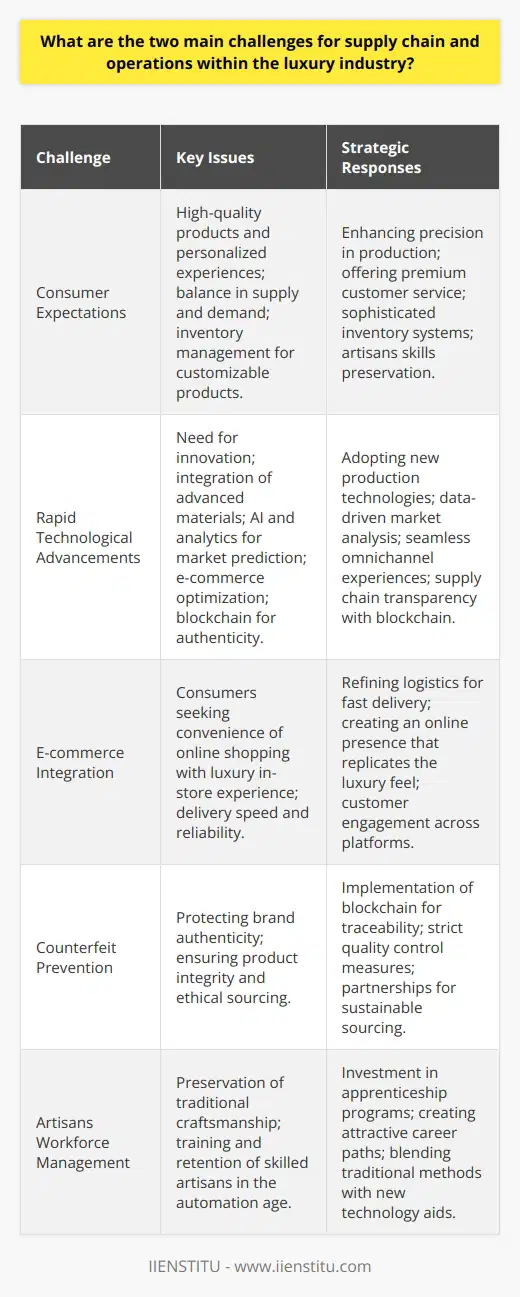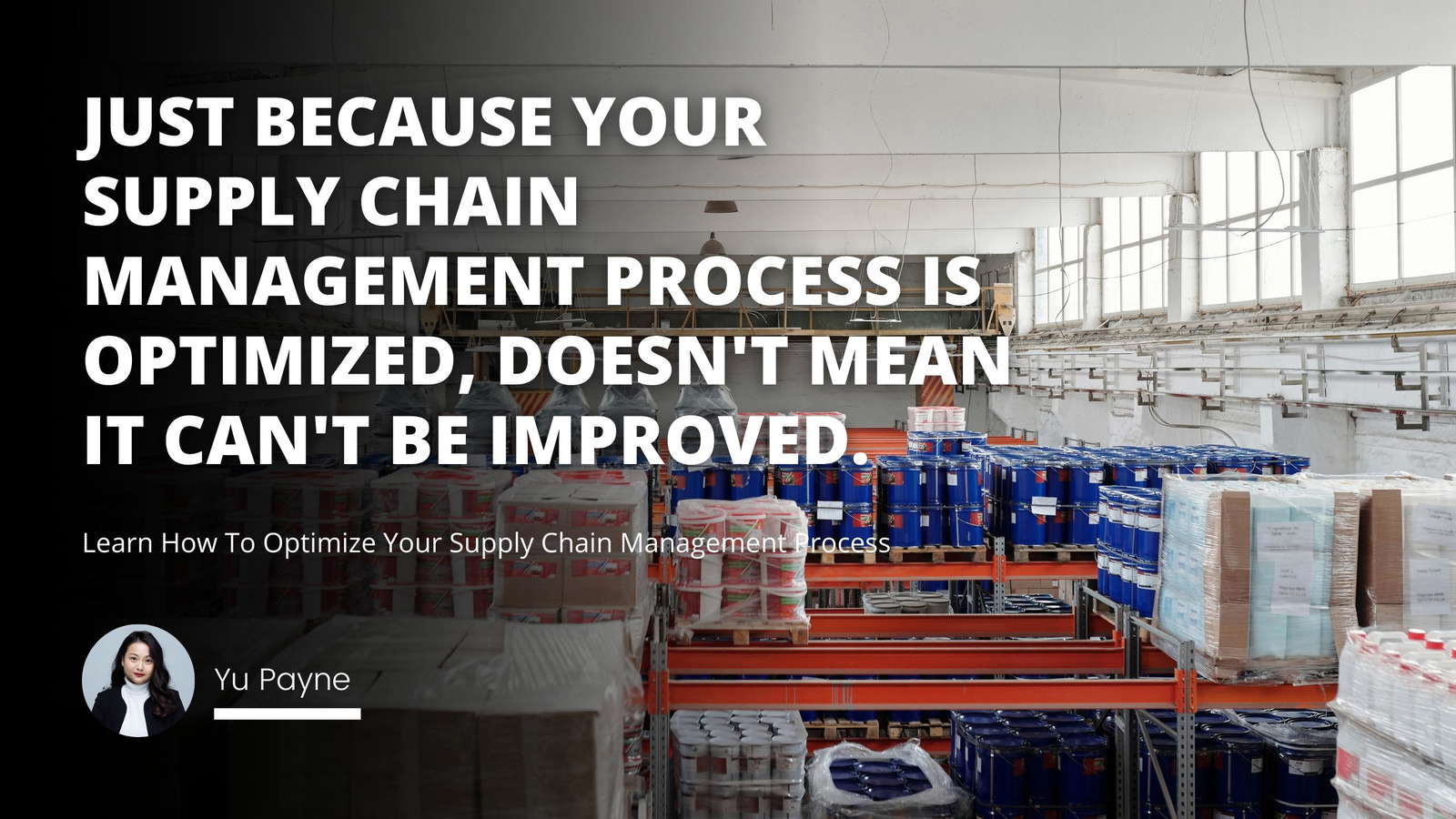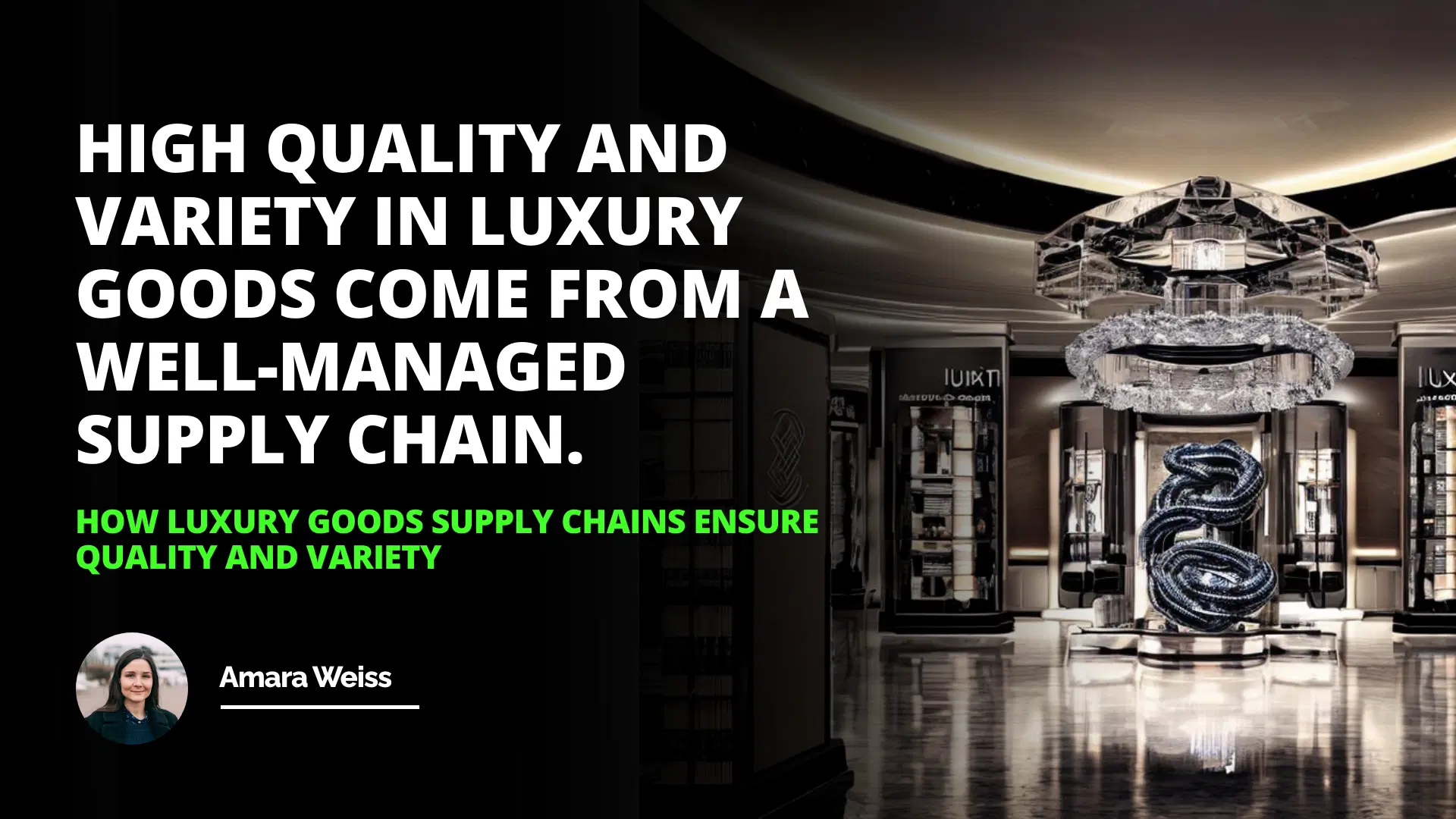
This article discusses the importance of quality and variety when it comes to luxury goods. It is important for companies to ensure that their products are of the highest quality and free from defects, and that customers have a wide range of options to choose from.
It is also important for companies to have a secure supply chain in place to protect luxury goods from damage and theft.
Introduction
Quality Standards
Variety of Luxury Goods
Protection of Luxury Goods
Conclusion
Introduction: Luxury goods are items that are considered to be of a higher quality than the average product. They are often associated with a certain lifestyle or status and are often seen as a symbol of wealth and success.
Luxury goods range from cars and jewelry to clothing and accessories. When it comes to luxury goods, quality and variety are of the utmost importance. Customers want something that is exactly the right size and color, and they don't want everyone to have the same product.
It is also very important to make sure that luxury goods are free from defects and damage. In order to ensure that customers get the best possible product, supply chains for luxury goods need to accommodate a wide range of products with plenty of protection to keep them safe.
Related course: Supply Chain Management
Quality Standards
When it comes to luxury goods, quality is of the utmost importance. The materials used to create luxury goods must be of the highest quality and should be inspected for any defects or damage.
Customers should be able to trust that the product they are buying is of the highest quality and will last for many years. Companies that manufacture luxury goods should also have strict quality assurance standards in place to ensure that all products meet the highest standards.
Variety of Luxury Goods
When it comes to luxury goods, variety is also key. Customers want to be able to choose from a wide range of products in order to find something that is exactly the right size and color.
Companies should strive to provide customers with a wide range of products that are unique and of the highest quality. This will help to ensure that customers are satisfied with their purchase and that they will be more likely to come back for future purchases.
Protection of Luxury Goods
In order to ensure that luxury goods are protected, companies should have a secure supply chain in place.
The supply chain should include measures to protect the goods from damage and theft. This may include secure packaging, tracking systems, and secure transport. Companies should also consider insurance for their luxury goods in case of any unforeseen circumstances.
Conclusion: Luxury goods are items that are of a higher quality than the average product. Quality and variety are of the utmost importance when it comes to luxury goods.
Customers want something that is exactly the right size and color, and they don't want everyone to have the same product. It is also very important to make sure that luxury goods are free from defects and damage.
Related article: Topic: Understand What Customers Value in Supply Chain Management
In order to ensure that customers get the best possible product, supply chains for luxury goods need to accommodate a wide range of products with plenty of protection to keep them safe. By following these guidelines, companies can ensure that their luxury goods are of the highest quality and are well protected.
High quality and variety in luxury goods come from a well-managed supply chain.
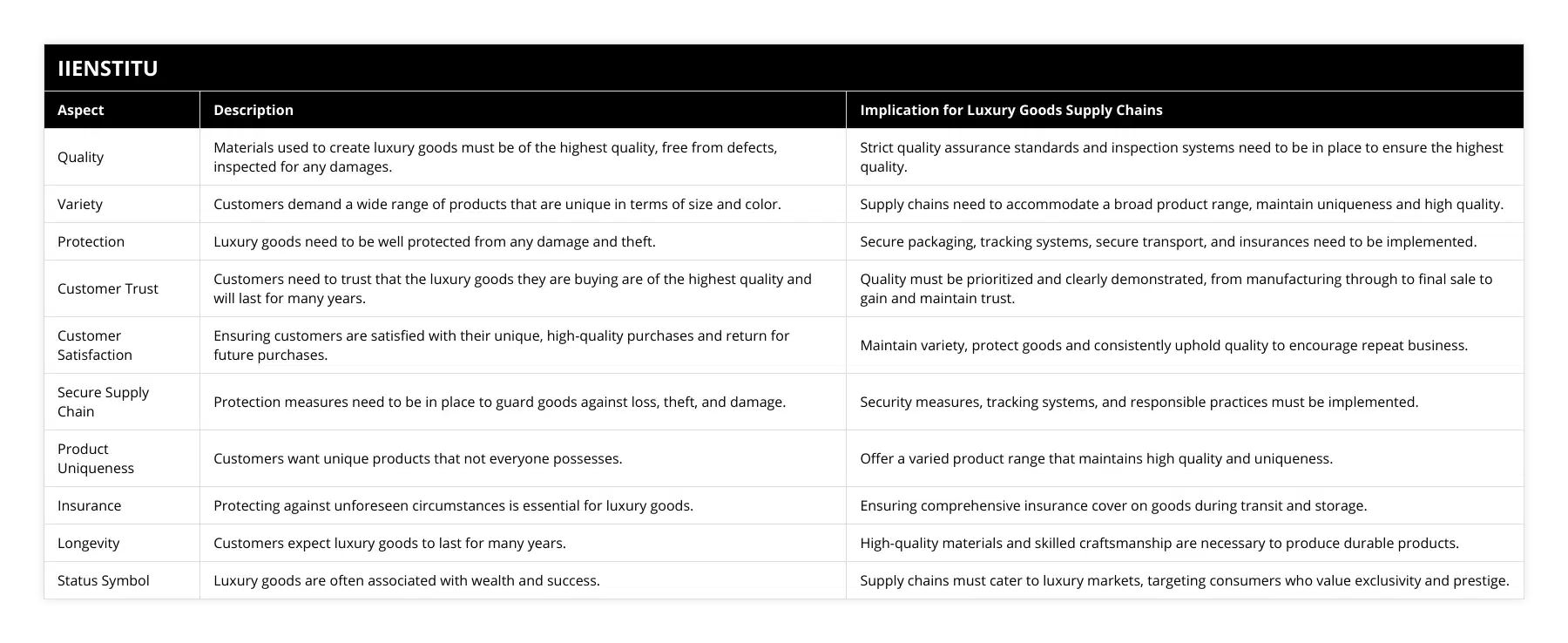
Frequently Asked Questions
What quality standards are used to ensure the quality of luxury goods in supply chains?
The quality of luxury goods is paramount in the supply chain process. Quality assurance measures are essential in order to ensure that the product reaches the customer’s high expectations. The quality of luxury goods is determined by the quality standards used in the supply chain. Quality standards refer to the criteria used to define the quality of a product or service and are often measured by the following criteria: functionality, reliability, usability, performance, durability, and aesthetics.
Functionality refers to the product’s ability to perform its intended purpose. This is a critical factor in ensuring the quality of luxury goods, as the product must perform as expected in order to meet the customer’s expectations. Reliability is another important factor, as customers expect products to last for a long period of time. Usability refers to the ease with which a customer can interact with and use the product. Performance refers to the efficiency and speed of the product, as well as its ability to perform as expected. Durability is determined by the product’s ability to withstand wear and tear over time. Lastly, aesthetics refer to the overall look and feel of the product, as well as its visual appeal.
In order to ensure the quality of luxury goods, suppliers and manufacturers must adhere to a set of quality standards. These standards are typically set by the customer, and may include additional criteria such as the use of specific materials, processes, and techniques. Consumers are increasingly demanding higher quality products, and suppliers must be able to meet these demands. Quality assurance measures are also used at the manufacturing stage to ensure that the product meets the customer’s expectations.
The quality standards used to ensure the quality of luxury goods in the supply chain are essential in order to maintain customer satisfaction. Quality assurance measures are necessary in order to ensure that the product meets the customer’s expectations and is of the highest possible quality. Suppliers and manufacturers must adhere to the quality standards set by the customer, as well as any additional criteria, in order to guarantee the quality of the product. By adhering to these quality standards, suppliers and manufacturers can ensure that the product meets the customer’s expectations and is of the highest possible quality.

How do luxury goods supply chains ensure a variety of products?
The global luxury goods industry is an ever-growing sector that presents unique challenges for supply chain management. Luxury goods have traditionally been defined as high-end, expensive items with an aura of exclusivity, and these items often have complex supply chains. It is therefore essential for luxury goods supply chains to be able to provide a wide variety of products in order to remain competitive.
To ensure a variety of products, luxury goods supply chains must focus on several core strategies. Firstly, they must have a strong understanding of the target market and the needs of the consumers. This includes conducting market research to determine which products are most sought-after, as well as the trends in the industry. This information can then be used to inform the buying decisions of the supply chain, ensuring that the right products are purchased.
Secondly, luxury goods supply chains must be able to source a wide variety of products from multiple suppliers. The suppliers must be carefully chosen to ensure quality and consistency, as well as the ability to deliver the goods on time. Additionally, the suppliers should also be able to provide a range of products that will meet the demands of the target market.
Thirdly, luxury goods supply chains must be able to store and transport the goods in a secure and reliable manner. This includes having adequate storage facilities, as well as the ability to transport the goods to the customers in a timely manner. Additionally, the supply chain must have the infrastructure in place to respond quickly to any changes in demand.
Finally, luxury goods supply chains must be able to manage their inventory effectively. This includes having a good understanding of the stock levels and the ability to anticipate changes in demand. This will help to ensure that the right products are available at the right time, and that the supply chain is able to meet the demands of the market.
In conclusion, it is essential for luxury goods supply chains to be able to provide a wide variety of products in order to remain competitive. This can be achieved by having a strong understanding of the target market, sourcing a wide variety of products from multiple suppliers, having the infrastructure in place to secure and transport the goods, and managing inventory levels effectively. By following these strategies, luxury goods supply chains can ensure that they are able to meet the demands of their customers.
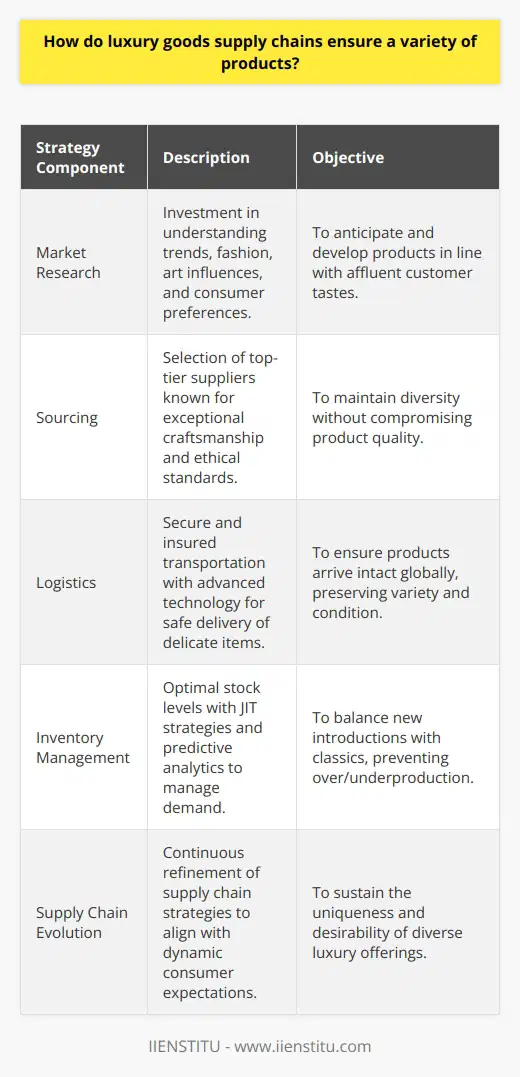
What measures are taken to protect luxury goods in supply chains?
In today’s world, luxury goods have become an increasingly popular item in the retail landscape, leading to an increased risk of theft and counterfeiting. As such, protecting these items during their transit and distribution has become a priority for many supply chains. This article will review the measures taken to protect luxury goods in supply chains and how companies can use these strategies to maximize their security.
One of the key strategies employed by many companies to secure luxury goods is the use of advanced tracking and monitoring. Companies can use integrated systems such as RFID tags and GPS tracking to monitor the movement of goods and detect any suspicious activity or theft. This data can then be used to alert authorities or take corrective action to ensure the safe delivery of the goods.
Another important measure is the use of secure packaging. Luxury goods often contain sensitive or valuable items, making them a prime target for theft. To reduce the risk of theft, companies can use tamper-proof packaging that is designed to protect the contents of the package. This could include the use of RFID-enabled packaging that is designed to detect any tampering or unauthorized access, or the use of secure locking mechanisms that make it difficult for thieves to access the contents of the package.
Finally, companies can also employ security personnel to protect the goods during their transit and distribution. This includes the use of uniformed guards and surveillance systems to ensure that the goods remain safe and secure throughout their journey. Companies can also work with their logistics provider to ensure that the goods are delivered directly to the customer, reducing the risk of theft and fraud.
In conclusion, there are many strategies that companies can use to protect luxury goods in supply chains. By using measures such as advanced tracking and monitoring, secure packaging, and security personnel, companies can ensure that their products remain safe and secure throughout the entire distribution process.
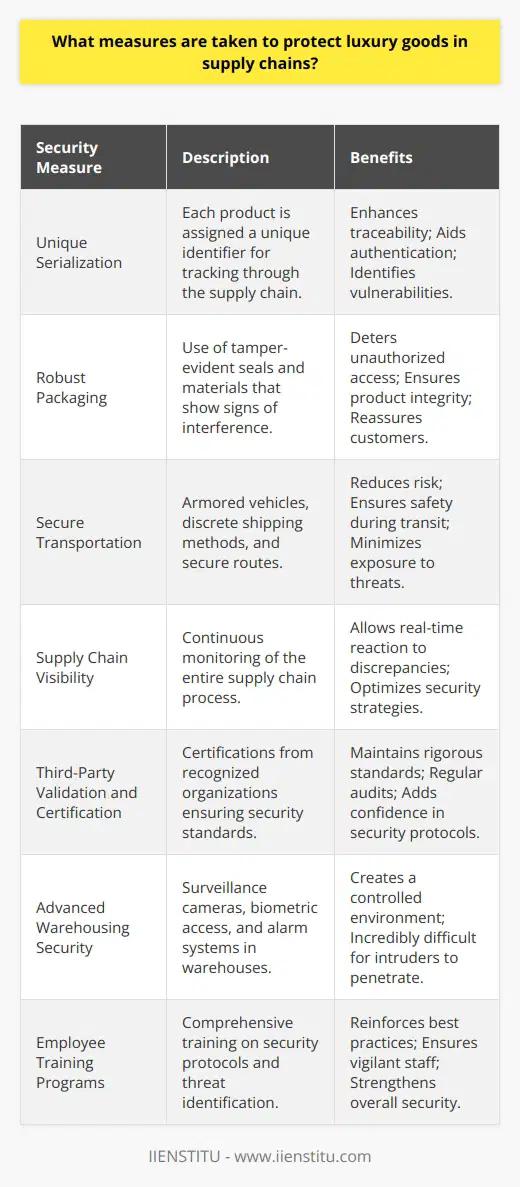
What are the key components of Gucci's inventory management strategy?
Effective Demand Forecasting
A critical element of Gucci's inventory management strategy is accurate and effective demand forecasting, which enables the brand to anticipate consumer needs and preferences. This proactive approach allows Gucci to produce and stock products according to the anticipated demand levels, thereby minimizing the risk of stockouts and overstock situations.
Limited Production and Exclusivity
Gucci strategically incorporates limited production runs in its inventory management, ensuring the exclusivity and premium status of their merchandise. By controlling the quantity of products manufactured, the brand successfully creates a sense of scarcity and encourages consumers to make immediate purchases. Furthermore, this approach significantly reduces the risk of excessive inventory buildup and the associated costs.
Efficient Distribution Channels
A streamlined and efficient distribution network is another vital component of Gucci's inventory management process. The brand leverages a well-organized supply chain to ensure that products are delivered to the right locations at the right time, allowing Gucci to maintain optimal inventory levels across its retail outlets, online stores, and partner resellers. This distribution model also provides the brand with more control over the availability and visibility of its merchandise, ultimately leading to higher sales.
Real-time Inventory Tracking
Gucci's inventory management strategy also employs advanced technologies for real-time inventory tracking and data analytics, ensuring that the brand always has access to accurate and up-to-date information regarding stock levels, sales performance, and product turnover. These insights are crucial in making informed decisions on replenishment strategies, production planning, and overall inventory management, facilitating a responsive and efficient system.
Sustainable Inventory Practices
Sustainability is a key focus in Gucci's inventory management strategy, as the brand continuously seeks to reduce waste, incorporate eco-friendly materials, and minimize its carbon footprint through various initiatives. One such initiative is the Gucci 'Scrap-less' program, which aims to eliminate excess inventory through the design and production stages. By embracing sustainable practices, Gucci not only enhances its reputation as a responsible and environmentally-conscious luxury brand but also ensures long-term stability and reduced waste in its inventory management process.
In conclusion, Gucci's inventory management strategy comprises a combination of effective demand forecasting, limited production runs, efficient distribution channels, real-time inventory tracking, and sustainable practices. These components work together to ensure optimal inventory levels, reduce costs, maintain the exclusivity of the brand, and promote a sustainable future.
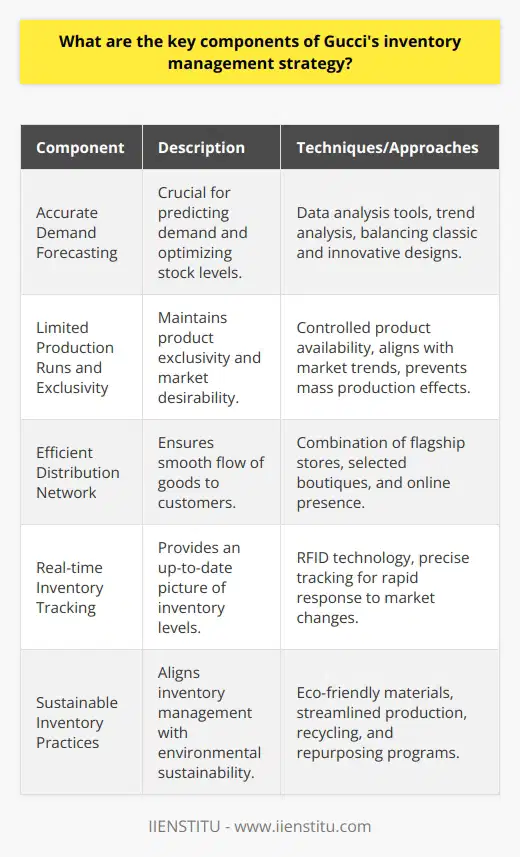
How has the supply chain management of Burberry evolved over the years?
Burberry's Supply Chain Evolution
Historical Background
In its early years, Burberry focused on producing outdoor clothing such as trench coats and weatherproof materials. The brand's supply chain was simple, involving direct relationships with mills and manufacturers. However, as Burberry expanded its reach, both geographically and through a broader range of products, its supply chain too had to grow and adapt.
Global Expansion and Diversification
Over time, Burberry transitioned from a primarily UK-based operation to a global fashion brand. This transformation necessitated a supply chain capable of sourcing materials and manufacturing products in multiple countries. Furthermore, as the brand's product offerings diversified, so did its supply chain, from apparel to accessories and beauty products. Burberry also embraced licensing agreements, allowing third-party manufacturers to produce and distribute its products, which added complexity to its supply chain management.
Digital Integration and Transparency
With the rise of digital technologies, Burberry has embraced innovative tools to improve its supply chain management. For instance, by implementing RFID (Radio-frequency identification) technology, Burberry has enhanced inventory tracking and data analysis. Online platforms and advanced analytics software have further enabled better communication between different parties involved in the supply chain. This integration has helped Burberry address challenges arising from its global and diversified operations while ensuring product quality.
Sustainability Initiatives
In recent years, Burberry's approach to supply chain management has incorporated environmental and ethical considerations to a greater degree than before. The brand has set ambitious sustainability goals and strives for transparency in its operations. Burberry has taken steps to reduce its environmental footprint, such as using renewable energy for its facilities and adhering to ethical labor standards.
Collaborations and Partnerships
Recognizing the value of collaboration, Burberry has formed strategic partnerships within its supply chain. These relationships allow for enhanced expertise and resources, facilitating a more efficient and effective supply chain. Burberry's partnership with the Sustainable Fibre Alliance, for instance, exemplifies the brand's commitment to sustainable sourcing and production practices.
Conclusion
Burberry's supply chain management has evolved significantly over the years, adapting to changes in the brand's global presence, product offerings, and market environment. By embracing digital integration, focusing on sustainability, and fostering strategic partnerships, Burberry's supply chain operations have become more efficient and better equipped to address modern challenges.
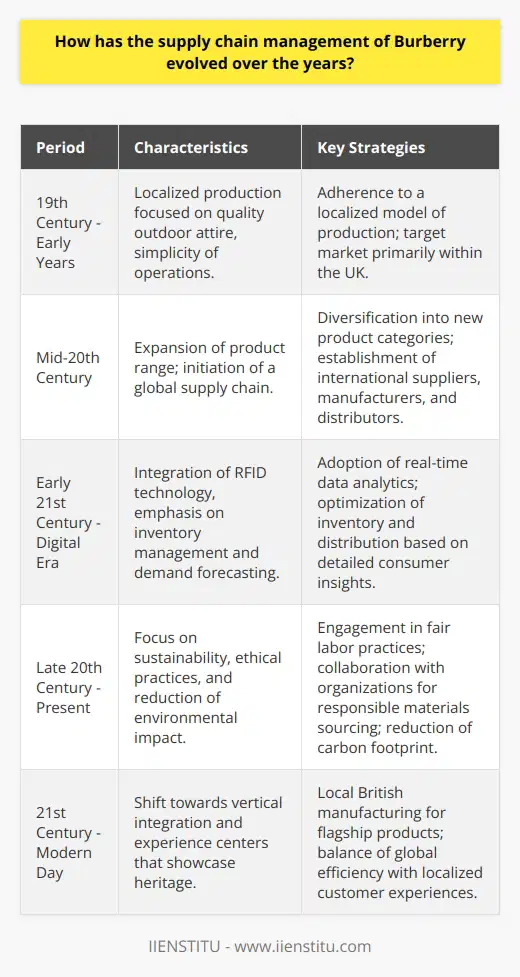
In what ways do LVMH suppliers contribute to the overall success of the luxury fashion industry?
LVMH Supplier Contributions
One of the primary ways LVMH suppliers contribute to the luxury fashion industry's overall success is by providing high-quality raw materials. Exclusive access to exquisite textiles, leathers, and other components guarantees that LVMH fashion brands maintain their distinctive reputation for superior products, catering to the refined tastes of their elite clientele.
Product Innovation and Collaboration
Additionally, LVMH suppliers play a critical role in promoting product innovation in the luxury fashion industry. By partnering with fashion houses on the development of new materials and technologies, suppliers facilitate the creation of cutting-edge designs and fresh product offerings. These collaborations keep the LVMH brands at the forefront of emerging fashion trends, ensuring their continued desirability to discerning consumers.
Sustainability and Ethical Sourcing
In response to the growing demand for sustainable and ethically sourced products, LVMH suppliers are actively engaged in transitioning to more environmentally and socially responsible practices. By adopting greener production processes and prioritizing ethical sourcing of raw materials, LVMH suppliers contribute to the luxury fashion industry's broader success by winning the trust of conscious consumers and reducing negative environmental impacts.
Reducing Lead Times and Enhancing Flexibility
Furthermore, LVMH suppliers contribute to the luxury fashion industry's success by reducing lead times and increasing adaptability through efficient production strategies. By ensuring timely and seamless delivery of raw materials and finished products, suppliers enable the rapid response to changing market demands and consumer preferences. In turn, this heightens the competitiveness of LVMH's portfolio brands and strengthens their market presence in the luxury sector.
Maintaining Consistency and Brand Identity
Lastly, LVMH suppliers consistently deliver high-quality products that uphold the brand identity of the luxury fashion brands under the conglomerate's umbrella. Through careful selection, rigorous quality controls, and thorough understanding of each brand’s unique requirements, suppliers contribute to building the perception of consistent excellence in the luxury fashion industry. This branded consistency plays a vital role in customer loyalty, thus contributing to the success and profitability of LVMH and the industry as a whole.
In conclusion, LVMH suppliers are instrumental in enhancing the luxury fashion industry's overall success through their commitment to quality, innovation, sustainability, efficiency, and maintaining brand identity. By doing so, they empower the LVMH Group and the industry at large to thrive and evolve in an increasingly competitive and dynamic market.
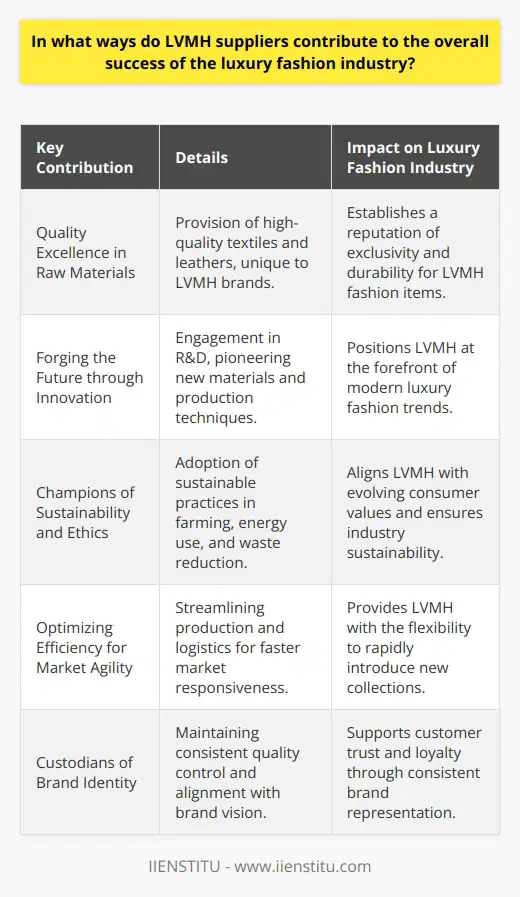
What are the key success factors of a luxury brand?
Brand Image
A luxury brand's success depends on its brand image. It needs to evoke exclusivity and high quality, leading to consumer desire. The brand's aura or mystique becomes an important factor in its overall attractiveness.
Perceived Exclusiveness
The perceived exclusiveness of the luxury brand is critical. Limited availability or high pricing often defines such exclusiveness. Consumers should believe they are part of an exclusive community when purchasing these products.
Quality and Craftsmanship
No luxury brand can succeed without placing a premium on quality and craftsmanship. This is the foundation for its claim of superiority and exclusivity. Every item must convey meticulous craft, setting it apart from regular commodity products.
Unique and Creative Designs
Unique and innovative designs are key. This puts the brand ahead of the curve, making it a trendsetter. A strong, consistent design aesthetic communicates the brand's identity and values, attracting a dedicated consumer base.
Strong Heritage
An established heritage can contribute largely to a luxury brand's prestige. Brands with a rich history and provenance, reflected in their products and narratives, tend to be more appealing to consumers. This legacy acts as a guarantee of the brand's continued commitment to quality and exclusivity.
Effective Marketing
Effective marketing strategies are crucial. Luxury brands must differentiate themselves and tell compelling stories about their products. The right marketing strategy can add a desirable dimension to the products, enhancing their appeal.
Premium Customer Experience
Last but not least, a luxury brand must offer a premium buying and ownership experience. This includes top-notch customer service, making the buyer feel special, and reinforcing the concept of exclusivity. This overall customer experience is critical in creating and maintaining brand loyalty, leading to repeated sales and referrals.
In summary, maintaining a strong brand image, assuring product quality, capitalizing on unique designs, leveraging strong heritage, implementing effective marketing strategies, and ensuring a premium customer experience are all critical factors in the success of a luxury brand.

What makes a luxury brand a luxury brand and how do we distinguish it?
Identifying Luxury Brands
A luxury brand represents the pinnacle of quality, design, and prestige in its respective industry. It demonstrates a meticulous attention to detail, often combined with creative and innovative designs.
Factors Defining Luxury Brands
These brands distinguish themselves through their unique selling propositions. They offer superior quality products and enrich customers' lives with an air of exclusivity. Furthermore, luxury brands often go a step further by providing an exceptional customer service experience and personalized touch.
Influence of Material and Craftsmanship
High-quality materials and superior craftsmanship are intrinsic characteristics of luxury brands. These brands prioritize durability and timeless aesthetics over fleeting trends. Such attributes add to the brand's value and the product’s longevity, guaranteeing consumer satisfaction.
Effect of Brand Heritage
Another significant feature of luxury brands is their heritage. Brand history, legacy, and tradition contribute to their reputation and help establish their position in the market.
Influence of Pricing
Furthermore, the pricing strategy is a practical way to distinguish luxury brands. These brands often boast high price points, which directly reflects their market positioning and exclusivity.
Role of Distribution Strategy
Luxury brands also use selective distribution strategies. They carefully choose their distribution channels to maintain their exclusive image, directly affecting consumer perception of the brand.
Impact of Unique Brand Aesthetics
The distinct aesthetic of luxury brands helps them stand out. Their unique visual identity, storytelling, and brand communication play a crucial role in attracting an elite clientele.
In summary, a multitude of factors define a luxury brand. These include the product's quality, design, brand heritage, pricing, distribution strategy, and unique aesthetic. These attributes all come together to create an exclusive image that distinguishes luxury brands from regular market offerings.

What are the two main challenges for supply chain and operations within the luxury industry?
Consumer Expectations
The first major challenge lies in meeting increasing consumer expectations. Luxury consumers often expect exceptional quality and a high level of customization. This brings significant stress to supply chain and operations management. The desire for exclusivity adds to the intricacy of fabrication. It increases the need for flawless quality control and supervision.
Rapid Technological Advancements
The second challenge is coping with rapid technological advancements. New technologies shape how luxury companies operate. Companies need to stay updated and adapt quickly to sustain competition. Technological changes can disrupt supply chains. Thus, luxury companies need to reimagine their operating models often. Adapting to these changes can be costly and time-consuming. Notwithstanding, companies that fail to innovate risk lagging behind.
In summary, luxury businesses face diverse challenges in managing their supply chains and operations. On one hand, they need to cater to consumers' high expectations for quality and customization. On the other hand, they need to continuously adapt their processes due to rapid technological advancements. Both challenges demand meticulous planning and execution. They have a significant impact on the overall performance and success of these businesses.
